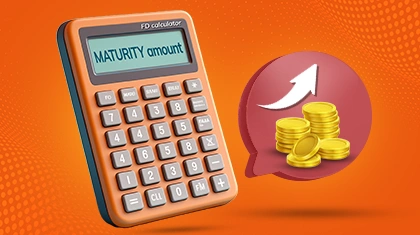THE
ORANGE
HUB
FD Interest Calculation of Simple vs. Compound Interest

Many investors prefer Fixed Deposits (FDs) due to stable returns and low risk. However, if you want to get the most out of your FD investment, you must understand how interest is calculated. This article explains simple and compound interest calculations using FD Interest Calculators, which can help you xmake better choices regarding the type of investment that would suit your financial goals.
What are FDs?
An FD is a type of term deposit provided by banks and other financial institutions in India. Here, money is held for a fixed tenure ranging from a few days to several years. In contrast to regular Savings Accounts with floating interest rates, an FD has a fixed rate throughout its tenure. This ensures predictability as the bank guarantees the amount anticipated in returns on principal.
Benefits of investing in FDs
There are several reasons why people choose this type of long-term savings plan:
- Security: Security is one of the major reasons why people opt for this scheme among other available options.
- Predictable returns: Another advantage is knowing what you will earn upon maturity. Unlike other alternatives, such as stocks, interest rates don't vary during the tenure. An FD is a secure option for those who have a risk-averse investing style.
- Flexibility in terms: Depending on the investor's financial goals, different terms can be selected to meet specific aspirations without exceeding the investor’s budget.
- Loan facilities: Banks offer loans against FDs without having to break the FD Account.
These features make FDs ideal among cautious savers looking for incremental growth without putting too much at stake.
Basics of FD Interest Calculation
Calculating Simple Interest in FDs
Simple interest is an easy method used for calculating returns on an investment. This formula can be represented as follows:
Interest = Principal x Rate x Time
Where:
- Principal refers to the initial sum invested
- Rate represents Annual Percentage Yield (APY) and
- Time denotes the duration of investment expressed in years
Example: If you were to deposit ₹ 10,000 at a 5% annual interest rate for three years, your earnings would amount to ₹ 10,000 x 0.05 x 3 = ₹ 1,500.
Calculating Compound Interest in FDs
Compound interest unlike simple interest considers both the principal amount and accumulated interest from earlier periods during each calculation round throughout the tenure. The formula is as follows:
A = P(1 + r/n)^(nt) where:
- P is the principal sum
- r stands for the Annual Percentage Rate
- n denotes the number of times uniform interval compounding occurs per annum
- t takes into account the number of years for which the principal is invested.
Example: You invest ₹1,00,000 into an FD Account that pays 6.9% interest compounded quarterly for 10 years. At this point, the final balance will be equal to ₹ 1,98,202*.
The advantages of compound interest increase with more frequent compounding periods, enhancing investment growth.
FD Interest Calculator: A Tool for Investors
Functionality
The FD Interest Calculator is an important tool that every investor should have access to while planning FD investments. These calculators compute interest automatically based on inputs given by the customer, whether simple or compound.
Value Inputs and Outputs
- To use an FD Interest Calculator, you must provide:
- Principal amount: The sum that you initially invest
- Tenure: The duration for which you invest
- Rate of interest: Annual percentage at which the investment multiplies
- Compounding frequency: How often the interest is compounded (for example, annually or semi-annually).
It usually gives the following results:
- Maturity value: Amount received after the complete period of investment
- Total interest earned: The overall interest accumulated during the investment term.
Advantages
One of the advantages of an FD Interest Calculator is that it gives investors a clear idea about their potential returns. By using this tool, you can experiment with different variables and understand the impact of compounding. Select an investment term which is in line with your financial goals. In other words, an Interest Calculator can be helpful for planning and optimising your investment strategy for FDs.
Comparison between Simple Interest and Compound Interest
When we talk about growing our savings, whether calculated on a simple interest basis or compounded annually, the calculation pattern can make a huge difference. Let us consider two hypothetical cases based on the FD Interest Calculator:
Scenario 1: Simple Interest
Investor A invests ₹ 1,00,000 into an FD Account, which has an annual rate of simple interest that equals 5% for 3 years. According to the formula of SI (i.e., P x R x T), the investor will earn Rs ₹ 15,000 as interest, making the maturity amount ₹ 1,15,000.
Scenario 2: Compound Interest
Investor B invests ₹ 1,00,000 but at a rate of 5% per annum compounded quarterly for 3 years. The maturity value based on the formula would be A= ₹ 1,00,000 (1+40.05) 4×3 = ₹ 1,16,084.80.
The difference becomes more significant when either a longer tenure or an increased compounding frequency is used. For instance, if compounding is done on a quarterly basis, investor B’s maturity amount would increase further. This illustrates how compound interest accelerates savings growth due to interest-earning interest.
Conclusion
Understanding how your money grows over time with FDs is an important step in effective financial planning. By using the FD Interest Calculator, you can determine the differences between simple interest and compound interest. Check how small changes in the compounding frequency or interest rate can significantly affect your investment's growth. You can use ICICI Bank’s FD Interest Calculator and align your investment choices with your long-term financial aspirations.
Scroll to top



